Written by Craig Allen Smith, PT DPT; Physical Therapist & Director of Smith Performance Center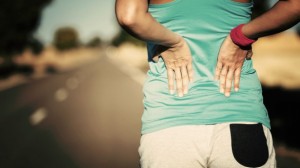 The Problem: Why is my back hurting?
The Problem: Why is my back hurting?
The healthy triathlete must combine mobility and stability in a seamless transition from swimming to cycling to running, or they break. The break occurs most often during the running component due to small, unnoticed problems that gradually lead to an overuse injury. Overuse injuries are most common at the knee and lower leg; however, the low back is an often sited area of pain and something I see regularly at my clinic.
The conversation with an injured triathlete begins like this:
“My back hurts, but it doesn’t stop me from training.”
Or, “The pain gets better and randomly gets worse. Normally, I manage it and keep going, but it has gotten worse lately.”
There are numerous variations in the low back story, like the pain is greater at faster paces, or worse during the first few miles of a run. The symptoms are dependent on unique characteristics that we cannot get into fully today; however, we will focus on the primary functional cause of irritating low back symptoms: the hip and the need for extension.
Why is low back pain such a common problem?
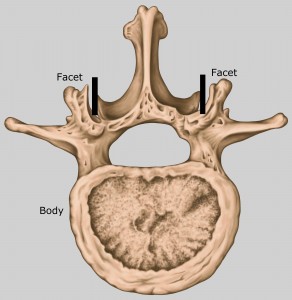
The answer requires a review of the anatomy. The lumbar spine is comprised of five vertebrae. The structure of the five vertebrae can be simplified to the body and the facets for this example. The critical concept here is the orientation on the facets allow for large movements in flexion and extension, but not much rotation or side bending (Figure 1). If you look at the black lines on the picture, you will see the place where the facets from the vertebra from above lock into the vertebrae below. At a certain amount of lumbar spine extension, the facets will begin to compress. Over a long period and many cycles of extension, this becomes painful.
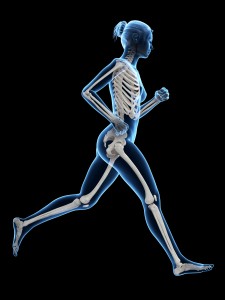
In comparison, the hip joint is a ball and socket that moves all over. It does not lock into just flexion and extension like the lumbar spine. When you see a runner coming down the street, the hips will move through a combination of flexion, internal rotation, and abduction into extension, external rotation, and adduction (understanding these movements is not important, just realize the pattern is complex and varies between triathletes). To further complicate the picture, a total of 21 muscles cross the hip joint and contribute to the complex symphony required for a single running stride. It is best to think of the hip as the primary mover during running while the rest of the leg (knee and foot) are springs that store and release energy throughout the gait cycle.As you start to run faster, the body will begin to cover more ground with each step. This is accomplished by two processes. First, the hip will extend more. Second, the low back will extend. You can quickly test this process by walking fast with large strides. You will notice your leg begins to go farther and farther behind the body with each stride. However, it is much harder to notice the contribution of the low back (Figure 2). If your hip is tight and cannot move into extension, the lumbar spine will attempt to make up the difference. The result is repeated smashing of the facets during every, single stride. To limit this problem, we have to figure out if your hip is tight.
There are two simple methods for self-assessment: Thomas test and prone knee flexion test.
The Tests
The Thomas test set up requires a table. You lie flat on your back with your butt right at the edge of the table. Bring both of your legs up to your chest and hold the back of your legs. Now let one of them gently descend toward the table. If you feel a stretch, pain, or your back lifts from the table, then you have a problem. A qualified examiner can evaluate what structure is causing your limitation, but it’s fairly clear that you are limited in hip extension.
The prone knee flexion test can be performed on a table or the floor. Lie down on your stomach and bring the heel of one foot to your butt. If you feel pain, tension in the back, or cannot get the foot to your butt then you once again have a limitation in hip extension.
Now there is a group of triathletes that do not present with limitations in hip extension, but are dealing with the same problem during the run. This can be explained by a concept of relative stiffness. You will always get motion where you are most mobile. Like I wrote before, the low back wants to flex and extend while the hip needs to be able to get about 10 to 15 degrees of extension to keep the lumbar spine from trying to help too much. However, if the muscles surrounding the lumbar spine do not contract appropriately, even athletes with mobile hips will demonstrate excessive lumbar extension and consequently the irritating back pain. If the hip is ‘relatively’ more stiff than the back, then the more mobile part, the low back, will be forced to move which leads to the same problem.
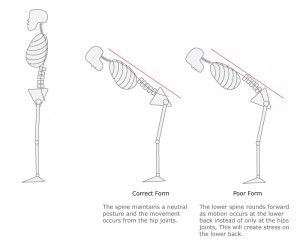
Solution
The solution is similar to the testing and very simple. Stretch the hip flexors using the Thomas test and prone knee flexion test positions. When you are stretching the hip, it is critical to limit any motion in the low back. Follow this up with exercises to move the hip into extension while keeping the low back in a neutral position. Exercises such as the hip hinge (Figure 3) and bird dog (Figure 4) are great as long as you focus on limiting motion to the hip.
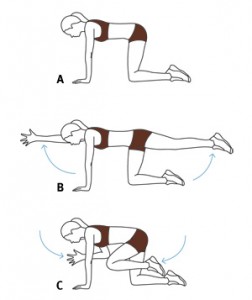
Dr. Craig Smith PT DPT is the owner and director of Smith Performance Center. The center was created to provide one-on-one physical therapy with strength and conditioning services, while researching new and innovative methods. Smith Performance Center provides long term care to reduce pain and improve movement through high quality physical therapy services, detailed movement analyses, and strength training. Learn more about Dr. Craig Smith at www.smithperformancecenter.com.
Check out TriSports.com’s muscle and pain relief section to see what other tools are available to help decrease and eliminate those nagging aches and pains to achieve your goals. ![]()
